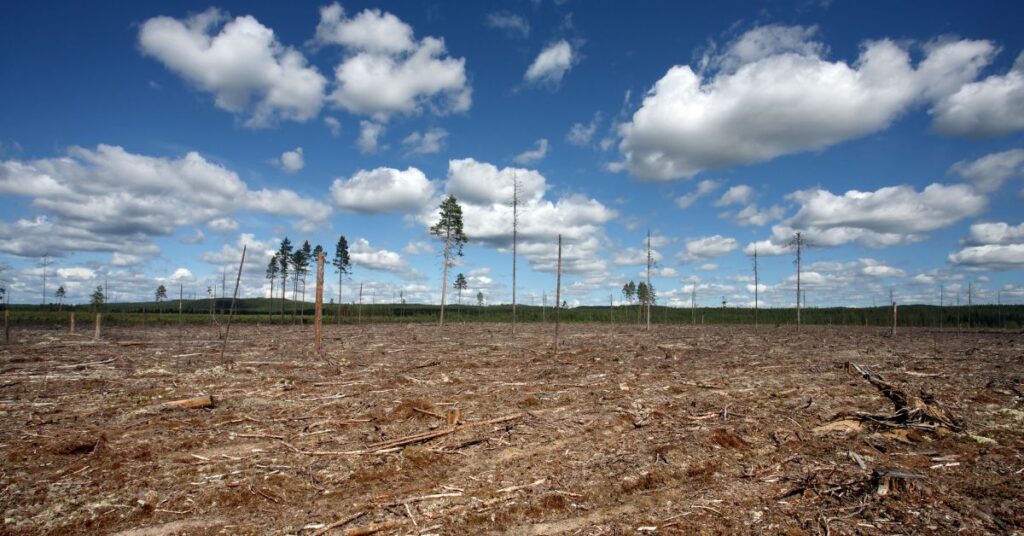

Industrial agriculture is turning the entire planet into a sacrifice zone, and we must act now to rectify the environmental impacts of food production.
The term sacrifice zone was coined during the Cold War to articulate the impact of nuclear testing. These were areas so damaged and devastated by nuclear radiation that they were deemed unfit for life. As time progressed, the term began to take on new meanings; by and large, it has referred to areas cataclysmically altered by human actions, including the production of nuclear weapons, fossil fuels, mining operations, and other industrial processes with high pollution rates.
Though we do not see or discuss them as often, the outsized environmental impacts of industrialized agriculture belong in the same category, producing sacrifice zones at such a large scale that they dwarf all other industries. That is because of industrialized agriculture’s ever-expanding economies of scale, which require large-scale monocultures to stay relevant on the world stage. These monocultures lack biodiversity and leave soils in a weakened state, creating a reliance on artificial fertilizers. In turn, monocultures built on weakened soils are more vulnerable to pests and diseases, and therefore they require poisonous pesticides that further weaken the soil food web.
This is a self-reinforcing loop of death: agricultural zones (and those downstream and downwind) become sacrifice zones.

Global changes in land use reflect the impact of agriculture on the environment. Worldwide, agriculture accounts for nearly 50 percent of all habitable land usage. Over 51 million square kilometers have been transitioned from natural habitat to agricultural land. This has fueled 90 percent of deforestation worldwide and remains the leading cause of deforestation in the Amazon.
This habitat loss has led to the near collapse of many ecosystems. Globally, wildlife populations have dropped by 73% on average since 1970—a catastrophic decline with potentially huge ramifications—and agriculture and aquaculture are the prevailing threat to 85 percent of the species currently under threat of extinction globally.
This devastation is not limited to terrestrial ecosystems. Fertilizer runoff has contributed to ballooning oceanic dead zones—perhaps the aptest example of sacrifice zones. Nearly 80 percent of eutrophication-causing water pollution is due to agricultural runoff, which creates low-oxygen environments in which life cannot survive. There are some 700 dead zones worldwide, the largest as of 2021 being 6,334 square miles in the Gulf of Mexico.[1]
And dead zones are only one example of how industrialized agriculture threatens ocean ecosystems. Of the 500 fish stocks monitored by the UN Food and Agriculture Organization, 35 percent are considered overfished today compared to only 10 percent in 1974.[2] The number of wild-caught fish plateaued in the mid-1980s, with increased fish production coming from aquaculture.
Though the threats posed to the environment by industrialized agriculture are daunting in their scale and implications, agricultural sacrifice zones need not exist, and we can return most agricultural land to its natural habitat without diminishing our capacity to feed the world’s growing population. We need to redefine agriculture, transitioning from agriculture as an act of extraction to agriculture as an act of conservation.
Agroecological practices that nurture plant and soil biodiversity can produce comparable yields without dangerous pesticides and toxic fertilizers. By incorporating long-living perennials and practicing no-till agriculture, we can rebuild soil diversity while sequestering atmospheric carbon.
We can also greatly reduce the land use requirements (currently 50 percent of all habitable land) by eliminating the inefficiencies at the heart of the food system, allowing for the reemergence of natural ecosystems. These inefficiencies are predominantly driven by livestock production. Although livestock accounts for only 18 percent of the global calorie supply, 77 percent of all land in agricultural production is used for grazing or growing livestock feed. That is over 39 million square kilometers for livestock alone, and it has an outsized contribution to climate change, biodiversity loss, and environmental degradation.

If we change nothing—if we continue on the path of destruction wrought by industrialized agriculture—we ensure a sixth mass extinction. Humanity would be incapable of surviving this. As former NASA researcher and professor of mathematics, Dave Pruett recently observed, environmental degradation is so pervasive that, “we’re all in the sacrifice zone now.” Although it may not always gain as much attention as other industries, agriculture is at the heart of our slow march toward a global sacrifice zone. Unlike in the energy sector, where technological innovations will be required to transform how we power societies, the path for transitioning agricultural systems to be more efficient and in line with natural processes is clear-cut. We do not need to wait for innovations. We can begin this transition today. We, and our collective institutions, are the only obstacles.
Copyright 2026 Center for Nutrition Studies. All rights reserved.